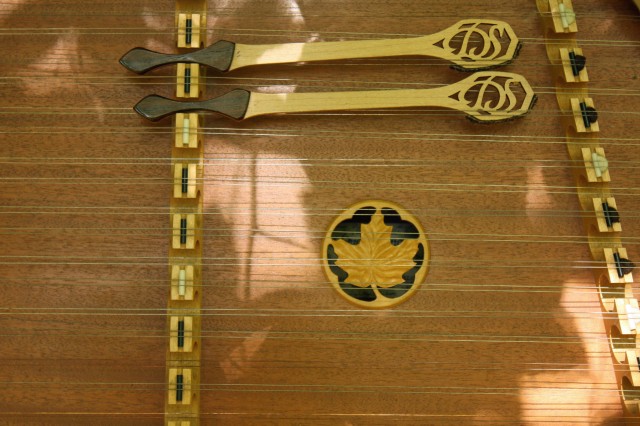It can be quite a challenge to choose your own instrument, because there are so many factors to consider in order to get what you’ll be happiest with, especially if you have particular goals and dreams for your own playing. Then again, if you really want to play an instrument, almost anything will do just to get started!
For the hammered dulcimer, my main instrument these days, I recommend that people try out lots of them. Craigslist or eBay can actually be a problem if you don't really know the different builders, because the builders and the instruments are all so different in sound quality and general quality.
There are maybe ten or twenty builders in the US that I highly respect for sound and stability; among them are Dusty Strings (Ray and Sue Mooers, who made my instruments), Sam Rizzetta, Nick Blanton, Master Works (Russell Cook), Song of the Wood (Jerry Read Smith), James Jones, Cloud Nine (Michael Allen), David's Dulcimers (David Lindsey), and Songbird (Chris Foss). These are among the best, I think, and many players agree with me --- but there certainly are other great builders as well.
You really need to try out various models by various builders before you decide which direction to take. I love the rich, full, fairly sustained, mahogany or sapaele approach of Dusty Strings, particularly in the models co-designed with Sam Rizzetta --- but that's because of the very pianistic approach I try to have. (And I'm such a fan that these days I'm the Virginia dealer for their instruments!) Other players may be looking for something different.
There are two primary construction designs to consider: 1) The most widely common nowadays is one in which the top soundboard is integrated with the sides, a box-like configuration, with a warmer, more sustained sound; most of the builders listed above make this design primarily. 2) The northern country dance-band design (not only northern in use, of course, especially since one builder above, David Lindsey, lives in southern Oklahoma!) has a 'floating' soundboard resting on a very sturdy frame; it has a fresh, crisp, punchy, less sustained sound. You may want to try both types and decide which appeals to you the most; maybe you'll want to have both!
Several other other factors that at least should be mentioned are
- size
- weight
- spacing between string courses (I think you can adapt to any spacing, really, though.)
- pitch range, which can vary from 2 1/2 octaves to 5 1/2 octaves
- loudness
- stability (how well it will stay in tune)
- whether it has extra chromatic notes
- whether it has dampers or potential for dampers
- woods used (mahogany, sapaele, spruce, redwood, and birch laminate are most common, but various others can be used, even Formica!)
- beauty to your eye
- whether you can have it made custom or whether it's a production model or it's pre-built one-of-a-kind
So I suggest that at least for starters you visit stores or shops and try a number of them. (The website everythingdulcimer.com has a good list of sources.) The most in stock that I have seen in one place have been at the store Song of the Wood in Black Mountain, NC, near the Great Smokies; if you're ever near there, that's one of the best places to try many dulcimer models! Or if there's a gathering or festival of dulcimer players near you, see if you can visit and compare everyone's instruments. A lot of vendors go every July to the ODPC Funfest in Evart, MI, and you can sample to your heart's content there! If you special-order an instrument after trying one, though, you still have to keep in mind that every individual one is at least slightly different in response just because every piece of wood is different.
Therefore I would suggest getting one you have actually played and fallen in love with if that's a possible route to take. My own Dusty Strings D600 is the eighth one out of the shop of its model, made in 1999 and first owned by Sam Rizzetta himself; I tried it at his house and he let me buy it. When I play other copies of the same model I'm intrigued with the different voices among them, including the significant factor that as of 2016 Sam, and then I, have heavily played mine for seventeen years, and the wood has gained a nicely mature character.
But... don't take too long making the decision --- you need to get playing!





Comments